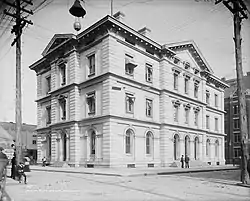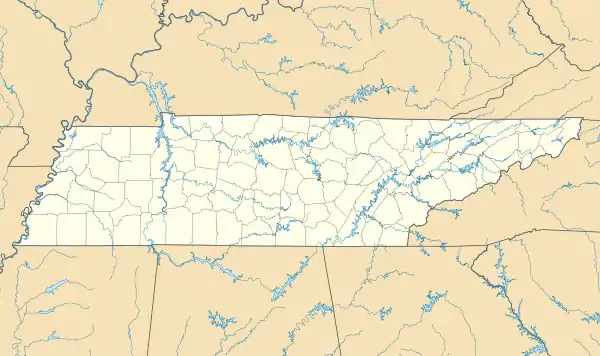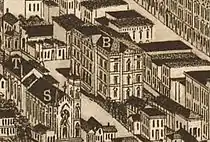Old Customs House (Knoxville, Tennessee)
The Old Customs House, also called the Old Post Office, is a historic building located at the corner of Clinch Avenue and Market Street in Knoxville, Tennessee, United States. Completed in 1874, it was the city's first federal building. It housed the federal courts, excise offices and post office until 1933. From 1936 to 1976, it was used by the Tennessee Valley Authority for offices. Expanded in 2004, the building is home to the East Tennessee History Center, which includes the Lawson McGhee Library's Calvin M. McClung Historical Collection, the Knox County Archives, and the East Tennessee Historical Society's headquarters and museum. The building is listed on the National Register of Historic Places for its architectural significance.[1]
Old Post Office Building | |
 The Old Customs House, as photographed by the Detroit Publishing Company in the early 1900s | |
  | |
| Location | Clinch Avenue and Market Street Knoxville, Tennessee |
|---|---|
| Coordinates | 35°57′49″N 83°55′7″W |
| Architect | Alfred B. Mullett[1] |
| Architectural style | Renaissance Revival |
| NRHP reference No. | 73001804[2] |
| Added to NRHP | March 20, 1973[1] |
Design
The Old Customs House is a three-story Italianate style building sheathed in East Tennessee marble. The smooth exterior walls contrast with rusticated quoins at the building's corners.[1] The former courtroom on the third floor is notable for its neoclassical detailing. Much of the original interior has been altered.[1]
History
The Customs House is situated on what was originally Lot 11 of James White's 1795 extension of Knoxville.[3] An 1871 map of Knoxville shows the property as an open grove surrounded by a few small houses.[4]

Through the 1850s, Congress was petitioned by cities across the country to provide courtrooms and post offices.
Congress appropriated funding for Knoxville's Customs House in 1856, and reappropriated the funding in 1869.[5] Construction of the original portion of the Customs House (at the corner of Clinch and Market), designed by U.S. government chief architect Alfred B. Mullett (1834–1890), began in 1871 and was completed in 1874.[5] The first floor was used as a post office, while the second and third floors were used for the federal court and office space for federal officials.[6]
As Knoxville's population quadrupled in the late 19th century, the increased postal activity left the Customs House critically overcrowded,[6] and the building was enlarged in 1910.[7] The building had a steam plant for heating and used electricity provided by the Knoxville Railway & Light Company.[8]
Knoxville's continued growth rendered the Customs House insufficient for the city's postal needs, and a new post office was built on Main Street in 1934.[7] Ownership of the Customs House was transferred to the Tennessee Valley Authority.[7] In 1976, ownership of the Customs House was transferred to Knox County for use by the Lawson McGhee Library's Calvin M. McClung Historical Collection and the Knox County Archives.[7]
In the 1980s, the East Tennessee Historical Society (ETHS) moved to the Customs House and set up the East Tennessee Historical Center.[9] The society opened the Museum of East Tennessee History in 1993.[10] In 2000, the second-floor corridor of the building was named Deaderick Hall in honor of librarian Lucile Deaderick (1914–2006).[11]

In 2004, a BarberMcMurry-designed eastern extension to the Customs House was completed, extending the structure the length of Clinch Avenue from Market to Gay Street.[12] This new complex, known as the East Tennessee History Center, includes the ETHS's headquarters, the Museum of East Tennessee History, the Calvin M. McClung Historical Collection, and the Knox County Archives. The Old Customs House is depicted in the ETHS logo.
See also
Notes
- Ellen Beasley, National Register of Historic Places Nomination Form for Old Post Office Building, 1 November 1972.
- "National Register Information System". National Register of Historic Places. National Park Service. March 13, 2009.
- Samuel G. Heiskell, Andrew Jackson and Early Tennessee History (Nashville: Ambrose Printing Company, 1918), p. 60.
- A. Ruger, "Bird's Eye View of the City of Knoxville, Knox County, Tennessee," 1871.
- United States Treasury Department, A History of Public Buildings Under the Control of the Treasury Department (Washington, D.C.: Government Printing Office, 1901), p. 553.
- L.M. Shaw, H.C. Payne, P.C. Knox, Letter from the Secretary of the Treasury, Postmaster-General, and Attorney-General Reporting in Regard to the Government Building at Knoxville, Tenn., 4 December 1902. Retrieved: 17 October 2011.
- Lucile Deaderick (ed.), Heart of the Valley: A History of Knoxville, Tennessee (East Tennessee Historical Society, 1976), pp. 135, 170.
- Presidential Commission on Economy and Efficiency, United States Post Office and Courthouse, Knoxville, Tenn., 8 January 1913, p. 888. Retrieved: 17 October 2011.
- W. Todd Groce, "A Brief History of the East Tennessee Historical Society," Journal of East Tennessee History, Vol. 66 (1994), pp. 1-9.
- "Museum of East Tennessee History Opens Tuesday," Knoxville News-Sentinel, 14 March 1993.
- Jack Neely, "Lucile Deaderick, 1914-2006: The Legacy of an Uncommon Life," Metro Pulse, 23 November 2006. Accessed at the Internet Archive, 5 October 2015.
- BarberMcMurry, East Tennessee History Center. Retrieved: 17 October 2011.
Sources
- Isenhour, Judith Clayton. Knoxville - A Pictorial History. (Donning, 1978), pages 122-124.
- Knoxville: Fifty Landmarks. (Knoxville: The Knoxville Heritage Committee of the Junior League of Knoxville, 1976), page 11.
External links
- East Tennessee Historical Society
- MPC Silver Award Photos
- Custom House under construction, circa 1872 – photograph on file at the Calvin M. McClung Digital Collection
- Custom House interior, circa 1894 – photograph on file at the Calvin M. McClung Digital Collection